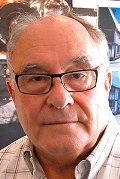From Wikipedia
"NAB Show is an annual trade show produced by the National Association of Broadcasters. It takes place in April, and has been held since 1991 at the Las Vegas Convention Center in Las Vegas, Nevada. The show's tagline is "Where Content Comes to Life". NAB show is the largest show for media, entertainment and technology. The NAB shows covers: broadcast TV, radio, production, post production, news gathering, streaming, cable TV, satellite TV, film restoration, data storage, data management, weather forecasting, industrial TV, FX, CGI, connected media, cybersecurity and more. NAB had 103,000 attendees from 161 countries and more than 1,806 exhibitors in 2016. There are also exhibitors in Las Vegas hotels not counted in the official convention center displays. In addition to the exhibitors' booths, there are lectures, panel discussions and workshops. In 2017, there will be over 200 of these sessions..."From No Film School
A playlist of coverage from NAB 2019. Worth watching.
NAB Show has live streams and recorded video coverage as do many of the product manufactures.
A bit of a toy fest. I like looking at the lighting, lenses, digital cameras and gripping gear.
I do have my heart set on Arri Alexa - just saying. And I would like to get to NAB.











